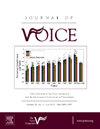Safety of Laryngeal Electromyography and Repetitive Stimulation
IF 2.5
4区 医学
Q1 AUDIOLOGY & SPEECH-LANGUAGE PATHOLOGY
引用次数: 0
Abstract
Objectives
Laryngeal Electromyography (LEMG) is a procedure used to assess electrical signals from laryngeal muscles. It is considered to be the gold standard test for examining vocal fold paresis/paralysis. Repetitive stimulation studies, which usually are performed at the time of LEMG, can aid in assessment of neuromuscular function. Electromyography poses risks to the patient due to the use of electricity and needles. The purpose of this paper was to evaluate the safety of LEMG and discuss the possible complications.
Methods
This was a retrospective review of patients from January 2015 through February 2022. Information from patient charts included age, sex, chief complaint, past medical history, family medical history, medications, social history, strobovideolaryngoscopy results, type of paresis, professional voice user status, presence of pacemaker, laryngeal electromyography and repetitive stimulation study results, and reported complications. Complications were considered to be anything that differed from the norm. Pain was included as a complication. Data were analyzed for relationships and significance.
Results
Five hundred patients were included. Eighteen of the 500 (3.6%) experienced complications. Four (2.1%) males and 14 (4.5%) females experienced complications. Nine of the 18 (50%) reported pain after the procedure, 1 (5.56%) had excessive bleeding (controlled with pressure), 5 (27.78%) reported voice changes, and 3 (16.67%) experienced difficulty with completion of the procedure. No patients with pacemakers or patients taking anticoagulants had complications, but repetitive stimulation studies were not performed on patients with pacemakers.
Conclusions
LEMG and repetitive stimulation studies are safe and effective procedures to examine laryngeal muscles. Repetitive stimulation studies are not recommended for patients with pacemakers.
喉部肌电图和重复性刺激的安全性。
目的:喉肌电图(LEMG)是一种用于评估喉部肌肉电信号的方法。它被认为是检查声带麻痹/瘫痪的金标准测试。通常在进行 LEMG 时进行的重复刺激研究有助于评估神经肌肉功能。由于使用电流和针头,肌电图检查会给患者带来风险。本文旨在评估 LEMG 的安全性,并讨论可能出现的并发症:本文对 2015 年 1 月至 2022 年 2 月期间的患者进行了回顾性研究。患者病历中的信息包括年龄、性别、主诉、既往病史、家族病史、用药、社会史、strobvideolaryngoscopy检查结果、瘫痪类型、专业用嗓者身份、是否使用起搏器、喉肌电图和重复刺激研究结果以及报告的并发症。并发症是指与正常情况不同的任何情况。疼痛也属于并发症。对数据的关系和重要性进行分析:结果:共纳入 500 名患者。500 名患者中有 18 人(3.6%)出现并发症。4名男性(2.1%)和14名女性(4.5%)出现并发症。18人中有9人(50%)报告术后疼痛,1人(5.56%)出血过多(通过加压控制),5人(27.78%)报告声音改变,3人(16.67%)在完成手术时遇到困难。没有使用心脏起搏器或服用抗凝剂的患者出现并发症,但没有对使用心脏起搏器的患者进行重复刺激研究:LEMG和重复刺激研究是安全有效的喉部肌肉检查程序。结论:LEMG 和重复刺激检查是安全有效的喉部肌肉检查方法,但不建议对佩戴心脏起搏器的患者进行重复刺激检查。
本文章由计算机程序翻译,如有差异,请以英文原文为准。
求助全文
约1分钟内获得全文
求助全文
来源期刊

Journal of Voice
医学-耳鼻喉科学
CiteScore
4.00
自引率
13.60%
发文量
395
审稿时长
59 days
期刊介绍:
The Journal of Voice is widely regarded as the world''s premiere journal for voice medicine and research. This peer-reviewed publication is listed in Index Medicus and is indexed by the Institute for Scientific Information. The journal contains articles written by experts throughout the world on all topics in voice sciences, voice medicine and surgery, and speech-language pathologists'' management of voice-related problems. The journal includes clinical articles, clinical research, and laboratory research. Members of the Foundation receive the journal as a benefit of membership.
 求助内容:
求助内容: 应助结果提醒方式:
应助结果提醒方式:


